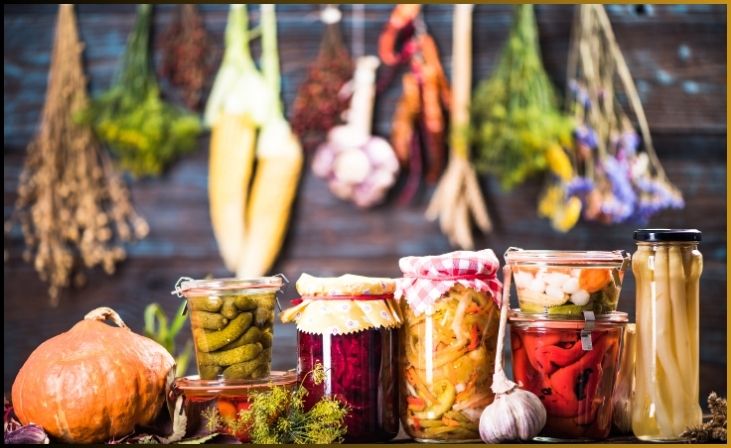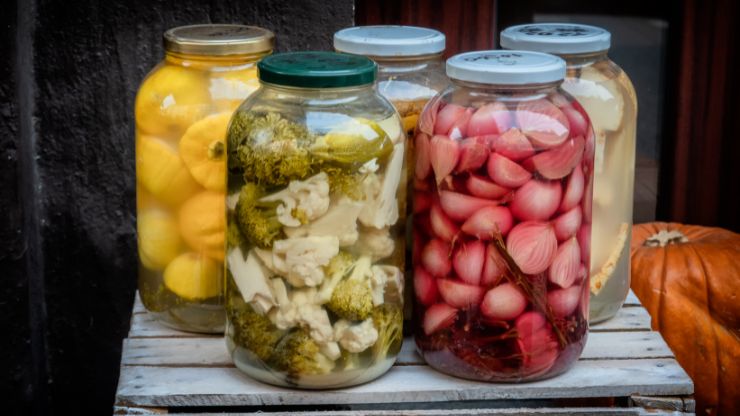Welcome to the world of fermented vegetables, a delightful and healthful culinary adventure that allows you to preserve fresh produce while enhancing its flavors and nutritional value. Making your own fermented vegetables is not only rewarding but also provides you with a pantry full of delicious and gut-friendly treats. In this article, we will guide you through the entire process, sharing insights based on expertise and personal experiences, backed by credible sources. Get ready to dive into the art of fermentation and unlock a world of delightful tastes and potential health benefits.
Table of Contents
ToggleMake Your Own Fermented Vegetables
Fermenting vegetables is a traditional practice that dates back centuries. The process involves creating an environment where beneficial bacteria thrive, converting sugars into lactic acid. This not only preserves the vegetables but also enhances their taste and nutritional content. Let’s explore the steps to make your own fermented vegetables at home.
1. Gather Your Supplies
Before embarking on your fermentation journey, gather the necessary supplies to ensure a smooth and successful process. You’ll need:
- Fresh vegetables (e.g., cabbage, carrots, cucumbers, radishes)
- Sea salt or kosher salt (non-iodized)
- Glass jars or fermentation crocks
- Weights to keep the vegetables submerged
- Clean towels or cloth covers
- A cutting board and knife
- A mixing bowl
2. Select the Best Vegetables
Embark on your fermentation journey with a mindful selection of fresh, organic produce, as the foundation of your culinary canvas. Optimal choices for this transformative process include the crisp crunch of cabbage, the vibrant hues of carrots, the refreshing allure of cucumbers, the peppery bite of radishes, and the earthy richness of beets. The decision to choose high-quality vegetables is not merely a matter of taste; it is a fundamental factor influencing the flavor profile and nutritional value of your fermented creations. Elevate your culinary endeavors by starting with the finest ingredients, ensuring that each pick contributes to the symphony of flavors and health benefits.
As you venture into the realm of fermentation, let the choice of vegetables be a conscious expression of your commitment to taste, quality, and well-being, resulting in dishes that are not only delicious but also a celebration of the nourishing power of nature.
3. Prepare the Vegetables
Embark on the first step of your fermentation odyssey by ensuring the pristine cleanliness of your vegetables. Begin the ritual by thoroughly washing and cleaning each vegetable, delicately removing any traces of dirt or debris that may linger. In the case of cabbage, unveil its inner essence by gently discarding the outer leaves and the core, paving the way for the transformation ahead. Dive into the artistry of preparation as you wield your knife to shred or chop the cabbage into small, manageable pieces, setting the stage for its fermentative metamorphosis.
Extend this precision to other vegetables in your repertoire, allowing your creativity to guide the slicing or dicing process, shaping them into sizes that align with your culinary vision. Let the meticulous attention to detail in the initial stages lay the foundation for a fermentation journey that promises not just flavors but a testament to the artistry that unfolds in each finely cut piece.
4. Add Salt and Massage
As you embark on the alchemical journey of fermentation, transition to a mixing bowl where the symphony of flavors begins to unfold. Grace the bowl with the bounty of chopped vegetables, and like a culinary maestro, sprinkle the sea salt or kosher salt generously upon this canvas of freshness. Recognize the salt not merely as a seasoning but as the alchemist’s catalyst, essential for conjuring the optimal environment for the transformative dance of fermentation. Engage your senses in the tactile artistry of massaging the salt into the vegetables, a rhythmic motion that encourages the release of their natural juices.
Witness the harmonious integration of salt and vegetables, a prelude to the symphony of flavors that will crescendo over time. This intimate process is not just a culinary ritual; it’s a communion with nature’s essence, as each stroke of your hands guides the vegetables toward a state of readiness for the magical metamorphosis that fermentation brings.
Related: Unlocking the Rich Flavors and Health Benefits of Fermented Garlic Paste
5. Pack the Vegetables
Continue the sacred ritual of fermentation by gracefully transferring the salted vegetables from their preparatory bowl into the sanctuaries of glass jars or fermentation crocks. As you guide the transition, invoke a gentle yet firm touch, ensuring the vegetables are nestled into their new abode with precision. Like a guardian of flavors, press down firmly to banish any lurking air pockets, allowing the vegetables to surrender to the embrace of the fermentative process. In this moment, acknowledge the sanctity of space – leave a deliberate expanse at the top of the vessel, an offering to the unseen forces of fermentation that will orchestrate the unfolding symphony.
Don't just scroll, subscribe!
BuzzTrail's unique web-stories are the cure for boredom you've been waiting for.
This space is not a void but a canvas for expansion, a nod to the alchemical dance that will transpire within the confines of the container. With each carefully pressed layer, you lay the foundation for the transformative journey that beckons, a journey that will fill the vessel not just with vegetables but with the promise of flavors evolving, maturing, and ultimately, delighting the senses.
6. Use Weights and Cover
Embrace the role of guardian to your fermenting creation by ensuring the vegetables remain submerged in their own ambrosial elixir. Introduce a symphony of weights – smaller jars, water-filled vessels, or purpose-crafted fermentation weights – delicately placed atop the vegetable tapestry. These weights, like ethereal sentinels, stand vigilant, orchestrating a harmonious balance within the fermenting vessel. Envision this arrangement as a sacred pact, a commitment to keep the vegetables immersed in the transformative alchemy of their own juices.
As a further act of protection, enshroud the vessels with clean towels or cloth covers, an elegant shield against the whims of dust and debris that might seek to intrude upon this sacred fermentation chamber. This act not only preserves the purity of the process but also serves as a gesture of reverence to the unseen forces guiding the metamorphosis within.
7. Fermentation Time
Embark upon the sacred timeline of fermentation, a dance choreographed by the unseen forces of time, temperature, and the essence of the chosen vegetables. This alchemical journey, akin to a cosmic ballet, unfolds over days or weeks, its rhythm attuned to the ambient whispers of the environment. As an eager guardian, partake in a daily communion with the evolving flavors, savoring the elixir of transformation that each passing day bequeaths to the vegetables.
It is a journey of discovery, where the palate becomes the compass, guiding the decision to cease the cosmic dance precisely when the symphony reaches its crescendo – the desired flavor achieved. In this mindful observation, the alchemist honors not only the process but also the essence of the vegetables, elevating the act of fermentation into a sacred communion with nature’s rhythmic cadence.
8. Store and Enjoy
As the cosmic ballet of fermentation concludes its celestial performance, gracefully remove the entrusted weights from the vessels, a symbolic gesture acknowledging the completion of a sacred dance. Seal the vessels with lids, akin to placing a celestial veil over the culmination of this alchemical masterpiece. With reverence, transfer the vessels to the cool sanctuary of the refrigerator, a haven that gently whispers to the fermenting forces, slowing their cosmic cadence to a tranquil lull. Here, amidst the chilled embrace, the fermented vegetables rest – sauerkraut, kimchi, pickles, and more – transformed from humble ingredients into ambassadors of flavor and nutrition.
With each jar holding a universe of taste, welcome these homemade delicacies into your meals, where they stand as both sustenance and testament to the alchemical artistry conducted within the sanctum of fermentation.
Health Benefits of Fermented Vegetables

In addition to their delectable taste, fermented vegetables offer numerous health benefits. The fermentation process creates probiotics, live beneficial bacteria that support gut health and aid digestion. These probiotics can enhance the gut microbiome, contributing to better immune function and overall well-being. Furthermore, fermented vegetables retain essential vitamins and minerals from the fresh produce, making them a nutrient-rich addition to your diet.
Conclusion
Congratulations! You’ve now learned the art of making your own fermented vegetables. This ancient culinary tradition not only provides you with tasty treats but also boosts your gut health and nutrient intake. Experiment with different vegetables and flavors to find your favorite combinations. Remember to follow safety guidelines, trust your instincts, and enjoy the delightful world of fermented vegetables.
So, why wait? Start fermenting today and unlock a world of delicious and nutritious possibilities!
Frequently Asked Questions (FAQs)
Can I use any type of salt for fermenting vegetables?
Can I use any type of salt for fermenting vegetables?
Yes, you can use either sea salt or kosher salt for fermenting vegetables. However, avoid using iodized salt, as iodine can inhibit the fermentation process.
How do I know if my fermented vegetables have gone bad?
How do I know if my fermented vegetables have gone bad?
If your fermented vegetables have an off-putting odor, strange colors, or a slimy texture, they might have gone bad. Trust your senses, and when in doubt, discard the batch and start anew.
Are there any safety concerns when fermenting vegetables?
Are there any safety concerns when fermenting vegetables?
Fermenting vegetables is generally safe if done correctly. Ensure that the vegetables are fully submerged in their juices and that all equipment is clean to prevent the growth of harmful bacteria.
Can I adjust the flavor of my fermented vegetables?
Can I adjust the flavor of my fermented vegetables?
Absolutely! Feel free to experiment with different vegetables, herbs, and spices to create unique flavor profiles. The possibilities are endless!

